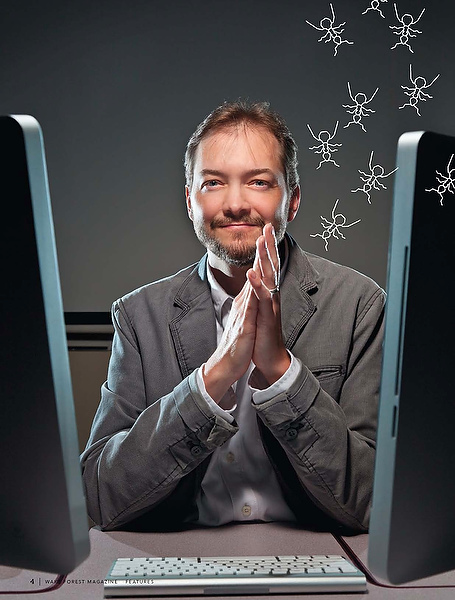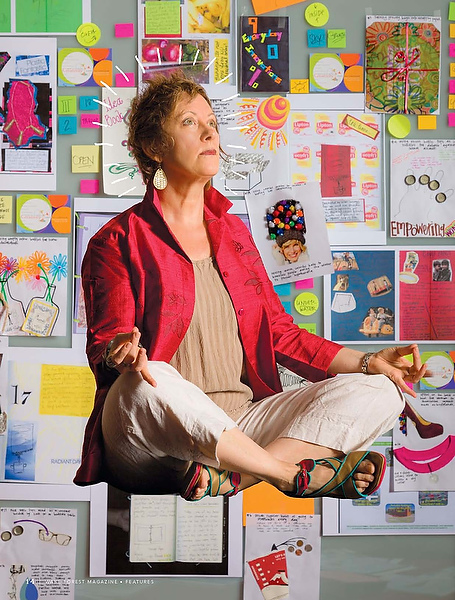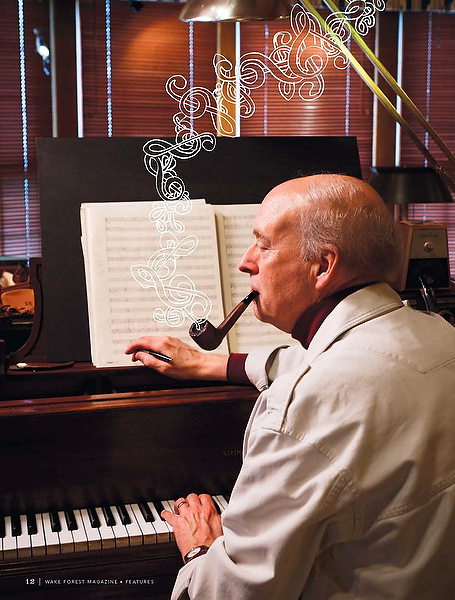 Challenge:
Challenge:
Protect computer networks from cyberattacks
Solution:
Mimic nature to deploy “digital ants” to seek out threats and alert human security experts
Co-researchers:
Pacific Northwest National Laboratory and students, including Michael Crouse (’10, MS ’12), named one of the nation’s top new inventors in 2011 by Inventors Digest magazine
“We looked at multiple types of insect models, bird models, fish models, a lot of different models, about how collective emergence intelligence can occur. One of the things we looked at is how does an ant colony defend itself? Is there anything that we can use for inspiration for defending computer systems? Ants can ramp up quickly to meet a threat and then ramp back down at nonthreatening times. It makes for a very efficient and robust system. As the digital ants move about a computer network, they leave digital trails modeled after the scent trails ants in nature use to guide other ants. Each time a digital ant identifies a threat, it leaves behind a stronger scent. Stronger scent trails attract more ants, producing the swarm that marks a potential computer infection.”
 Challenge:
Challenge:
Make Spanish come alive
Solution:
Expose students to Spanish speakers through service work in Winston-Salem organizations
Recognition:
A 2012 Teaching Innovation Award for curriculum from Wake Forest’s Teaching and Learning Center
“To learn a language you have to create a linguistic, authentic environment, places where students can use the language. What better way to do that than to take them out in the community, out of the Wake Forest bubble, and serve the Hispanic community? It’s important that they know the city and community that they are living in and become responsible citizens. That’s why I partner with Second Harvest Food Bank, the Community Care Clinic, El Buen Pastor, AIDS Care Services, the Hispanic League and local schools. Not only do they (students) practice their Spanish with native speakers, they face all sorts of challenges and different circumstances. It’s an eye-opener for them.”
 Challenge:
Challenge:
Invent new ways to teach physics and biophysics
Solution:
Create hands-on, interactive and digital approaches, including an electronic college textbook, and CellCraft and Biobotz, a video game and animated film, respectively, about cell biology for middle-school students
“You have to connect with students in an interactive way. One of the classic demos that new physics professors use is to break a brick or cinderblock on someone’s chest, using a sledgehammer. One of my colleagues made it even more impressive by putting a bed of nails between the brick and the person’s chest. Imagine a board 2-feet-by-2-feet filled with pointy nails pointed down into your chest. That’s what I had on my chest for my teaching demo before I was hired. I handed the sledgehammer to a student, and he smashed it. I wasn’t injured, because the brick has so much mass and thus so much inertia it doesn’t move very far or very fast. It’s such a visual reminder to students of what inertia is. The student with the sledgehammer will remember that better than any other student.”
 Challenge:
Challenge:
Make faculty development more appealing
Solution:
Pedometers and Pedagogy, a voluntary, weekly walk-and-talk time for faculty to amble around campus with colleagues to discuss teaching concerns, questions and ideas
Recognition:
Finalist for a 2011 POD Innovation Award, given by the Professional and Organizational Development Network in Higher Education
“Wake Forest teaches the whole student, so we need to also develop the whole faculty member. There’s a lot of new research that shows that walking has multiple benefits: physical fitness, stress reduction, enhancement of cognitive abilities and increases in creative thinking. It challenges the assumption that your intellectual, physical and emotional well-being aren’t connected. Another benefit is building a sense of community. We’ve had faculty who are brand new as well as senior faculty, from different departments, who never would have met otherwise.”
Challenge:
Compose a wide range of works commissioned by orchestras, chamber ensembles, solo performers and choral groups from around the world
Solution:
Find inspiration in unexpected places: nature, a poem, a picture, scripture, mowing the lawn, listening to his wife, Paula, or watching a curious Shetland sheepdog named Darby
“Upon entering my composition studio each morning my first action is to light one of my many beloved pipes. I find mystery and inspiration in tobacco smoke. Other composers have experienced it, too, especially J.S. Bach, who wrote a beautiful poem (“Edifying Thoughts of a Tobacco Smoker”). Although seeds — those small musical notes, rhythms and rests that just may eventually become a composition — often come from unexpected places, others come from the age-old tool of improvisation. There is something truly freeing in just letting your fingers wander the keyboard, where a valuable musical discovery may emerge. Only by putting it aside until the next morning will you confirm whether it is the greatest idea since the invention of the wheel, the most inane idea ever to land on Earth, or something in-between. Through compositional craft and a little luck, ideas then, somehow, grow up to become living music.”
 Challenge:
Challenge:
Activate students’ creativity
Solution:
Guide students in designing “everyday innovations” to proposing “future worlds” in a class called Foundations for Creativity and Innovation
“Creativity is the number one critical competency for students of the 21st century. All creative process starts with exploration. It’s rigorous, like unpacking the details of what life feels like. Students learn how to cultivate imagination, catalyze action and develop innovation skills, which ask: What’s the problem? What’s going to make it better? Innovation needs design processes, and, like creative processes, they spring from formal concepts and methods that change lives. Students develop an idea book of improvements in their Wake Forest life, then translate their ideas into sister designs for people in radically different and difficult circumstances in other parts of the world. They become empathic global citizens. They learn how to be critical in their creativity and how to develop astute connections and offer lively transformative visions for a future world.”
Challenge:
Teach complex scientific topics
Solution:
Use movement to bring concepts to life in the class Movement and the Molecular, which unites chemistry and dance
 “Many scientific ideas involve things moving. If you’re trying to teach those things using a chalkboard or even PowerPoint, how do students grasp things happening in a cell that are not static? You can’t really explain something in writing that happens in three dimensions. It makes much more sense if you act out the process. A lot of my science students are also in the performing arts. How can I encourage that aspect of their lives by valuing what they do and linking that with their science?”
“Many scientific ideas involve things moving. If you’re trying to teach those things using a chalkboard or even PowerPoint, how do students grasp things happening in a cell that are not static? You can’t really explain something in writing that happens in three dimensions. It makes much more sense if you act out the process. A lot of my science students are also in the performing arts. How can I encourage that aspect of their lives by valuing what they do and linking that with their science?”
– Alexander (right)
“I started out doing research with dance and Parkinson’s disease. That got me talking to scientists more and thinking about courses that bridge our disciplines. Choreography lends itself to be about virtually anything, so why not DNA replication, why not a complex protein synthesis? We’d like to take it a step further and have our students become the educators and go into a middle school and say to the students, ‘What would your DNA dance look like?’ “
– Soriano (left)











